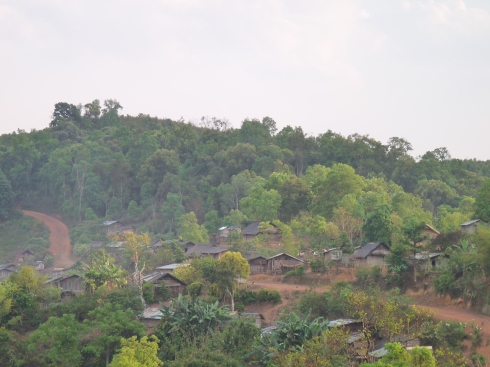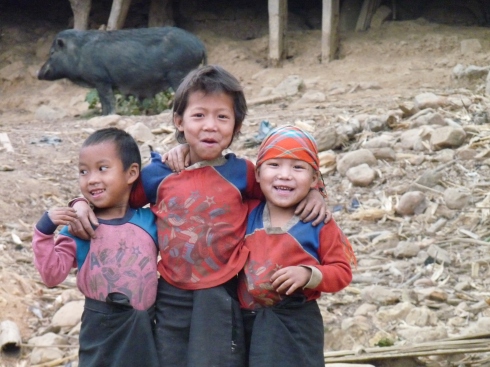It is difficult, nay, nearly impossible for modern, and especially modern Western people to conceive how truly different they are from others outside of their own background. We have become incapable of seeing the world outside of a given lens, having lost forever any understanding that we ourselves and our world were once radically different. And, by extension, we do not conceive that the world can (or should) function in any other way than what confirms our predispositions.
Having lived in Korea, I had inklings of this fact, for there parts of the old world lives on under a veneer of modernity. But it was not until I ventured to the far mountainous north of Laos, amongst the Akha people, that I saw a radically different world in full, natural bloom.
The Akha are a hill tribe people, one of the many ethnic minorities in Laos (or the Lao People’s Democratic Republic). In the past century they’ve migrated from parts of Yunnan, in China, and perhaps from areas closer to Tibet as well.
When you hear hill tribe, you should certainly note the “hill” part. Because it informs so much about the Akha themselves and also what you have to do to get there. From the crossroads town of Boun Tai, I took an hour-long ride by songthaew up a road of dusty red clay. We passed villages covered in road dust, with plastic litter along the sides of the dirt track. There were spots along the way where construction was going on — some looked like preparations for future dams, others for electrical lines.
From the first village where we were dropped off, to the three others I would visit over the next few days, it was plain that I had stepped into a place distinct from my own world. It was beyond medieval —- it was tribal primitiveness, the crystallized experience of hundreds of years of inherited living in a single environment. We hiked up and down the steep ridges, passing through large swaths of burned land, used for growing dry mountain rice. The smell was incredible —- rich and burnt, yet fresh at the same time, perhaps because it felt drier and freer than the damp, still air of the forested valley bottoms. A family was clearing half-burnt trunks —- they gawked at me in curiosity. Bamboo huts often occupy the middle or periphery of such fields; it seems that they are used for storing tools or perhaps sleeping in during the planting season, since the villages were often a fair distance away from the fields.
The Akha were a tad apprehensive at first, in every village we came to. I’m used to being stared at, but this was a fearful sort of staring, mainly by the women. After long awkward moments, they often became more congenial. This depended on the family, though, a phenomenon similar to what I experienced in Mongolia.
Most Akha houses are made of wood planks, with hard-packed dirt floors, and no chimney. They were long and open inside; some would have an upstairs where the whole family would sleep together, one right next to the other, even wife with mother-in-law. Everything inside had a black tinge from the smoke, which hung in the air and stung your eyes as it wound its way toward the door. There was no electricity, save for flashlights, which they used to embroider in the near-complete darkness inside the house. The men of the house often did some of the cooking. One morning I awoke and found the chief chopping up yellow fruit —- much like a hard, dry-tasting tomato, but more citrus-y —- that he had gathered from the forest, with a machete.
The kids ran around freely, covered in dirt, the very little ones often with no pants. This kid picked a fight with me because I took his friends’ picture but not his.
He slugged me until I took this snapshot, then was content. Later he tried to fence with me using a piece of bamboo.
The last village we were in was the most interesting. There was a lot of trash, especially on the main thoroughfare and far more than other villages. This was almost certain because they had a rough motorcycle road leading to the middle of the village. Other villages were accessible only by footpath and were consequently far more isolated. But the people were also less standoff-ish, especially when I pulled out a phrasebook that had Akha in it. Each group of Akha not only lived close to each other in the villages themselves, but the villages themselves were related in a way. The final village had been established twenty-five years ago with people from the previous village (itself established seventy-five years ago). Starting with fifteen families, they had grown to eighty-seven families. The chief was a very welcoming and generous man. He shared lots of rice whiskey with us, which was perhaps some of the finest alcohol I’ve ever quaffed. Normally any kind of rice liquor is extremely fiery and harsh, but the chief’s was smooth and warming all the way down. The chief seemed to like us and gave my girlfriend permission to photograph his wife and daughter-in-law doing embroidery after the meal. He was delighted when he gave him Korean and American bills and coins. He said he would show them off whenever there was a funeral or clan meeting next.
They live in a totally different world. Up there on the hills, no electricity, squealing pigs running around eating shit (literally), burning up the hills to grow rice, knowing almost nothing but their neighbors and how to survive. They knew nothing about other countries or their location, other than Vietnam, Thailand, and China. They didn’t know about Korea. They thought the U.S. was close by. They are completely poor in everything material and extremely rich in everything relational. They talked about the ten elephants that came through the village the night before – yes, way up on the ridge, the elephants are even there. This seemed like their greatest worry in the whole world. You could add disease, crippling, widowing, but that’s what they’ve always dealt with, and it is intrinsic to their environment. To them, there are no forces, invisible and sinister and distant, that threaten them. No vast empires, ideologies, or powers are within their comprehension.
In their close-knit life, I could only think about the distinction H.G Wells made, noted by Lord Kenneth Clark, between “communities of obedience” and “communities of will.” The Akha are the former, without a doubt. Their natural environment, the necessity of survival, and their isolation makes it so. There is obviously no room for individuality. Yet as individuals they are perhaps as interesting and varied as we are, maybe more so.
Now the Akha are animists and understand some truths but not others; will is necessary in the search for truth; but so too is peace and contentment in the truths we already know. Obedience to what we know and, more importantly, to whom life, in all its mystery, has bound us, is equal to will.
We totally do not understand that relational aspect of the Akha and, indeed, we deny it in our contemporary modern civilization. We have gone from a prescriptive ordering of civilization’s necessary institutions, powers, and laws, to an activist one. Yet these things are incapable of acting humanly in their activism. But activism is necessary for life, especially life together. We must do things to solve our problems, disagreements, predicaments, shortages of material necessities, et cetera. These things are done best, most compassionately, on a human scale — that is, as close to humans themselves as possible. I am sure that the Akha chief has great power to solve disputes and make commands in his community. Yet he is immediately bound to those people, for he lives with them, survives with them. What better can temper power and guide action than sleeping, waking, eating, washing, talking with the same people mere yards from you for all your life?
What a world theirs is, where people and their life together are the force and the rule for all existence. Would that it were so everywhere.
(For the second in this two-part series, click here.)







Inveigh against me.